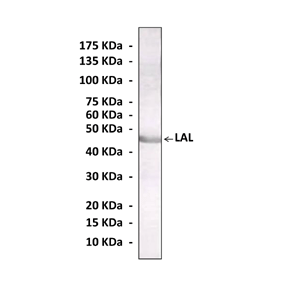Anti-LAL: Mouse Lysomal Acid Lipase Antibody |
 |
BACKGROUND Lysosomal acid lipase (LAL, E.C. 3.1.1.13) is a hydrolase involved in the intracellular degradation of lipoproteins. LAL was first described in fibroblasts, and since then found in all analyzed tissues with the exception of erythrocytes. The enzyme hydrolyzes cholesterol esters and triacylglycerols endocytosed by the cells and transferred to the lysosomal pathway. Cholesterol released by this reaction equilibrates with the cytoplasmic cholesterol pool and contributes to the regulation of intracellular lipid metabolism by three mechanisms: (1) free cholesterol reduces the activity of 3-hydroxy-3-methylglutaryl coenzyme A (HMG-CoA)-reductase, the key enzyme of cholesterol synthesis; (2) cholesterol activates its own esterification by acyl-CoA-cholesterol acyltransferase; and (3) cholesterol downregulates low-density lipoprotein receptor expression, which subsequently reduces cellular cholesterol uptake.1 LAL deficiency produces two human phenotypes: Wolman disease (WD) and cholesteryl ester storage disease (CESD).2 In addition, LAL can be used as an enzyme therapy to reduce atherosclerotic lesions in a mouse model. It was demonstrated that lysosomal acid lipase affects the atherogenesis by at least two mechanisms: (1) direct targeting of lesional macrophages with resultant decreases in cholesteryl esters and triglyceride in the lysosomes of macrophages in the lesions; (2) systemic effects that mediate the liver to reduce the hepatic cholesteryl ester and triglyceride release, possibly leading to reduced production of VLDL and LDL.3
REFERENCES
1. Sando, G.N. & Rosenbaum, L.M.: J.Biol. Chem. 260:15186-93, 1985
2. Cortner,J.A. et al: Pediatric Res. 10:927-32, 1976
3. Du, H. & Grabowski, G.A.: Curr. Opin. Lipidol. 15:539-44, 2005
2. Cortner,J.A. et al: Pediatric Res. 10:927-32, 1976
3. Du, H. & Grabowski, G.A.: Curr. Opin. Lipidol. 15:539-44, 2005
Products are for research use only. They are not intended for human, animal, or diagnostic applications.
Параметры
Cat.No.: | CP10150 |
Antigen: | Purified recombinant human LAL fragments expressed in E. coli. |
Isotype: | Mouse IgG2a |
Species & predicted species cross- reactivity ( ): | Human |
Applications & Suggested starting dilutions:* | WB 1:1000 IP n/d IHC n/d ICC n/d FACS n/d |
Predicted Molecular Weight of protein: | 45-54 kDa |
Specificity/Sensitivity: | Detects endogenous LAL proteins without cross-reactivity with other family members. |
Storage: | Store at -20°C, 4°C for frequent use. Avoid repeated freeze-thaw cycles. |
*Optimal working dilutions must be determined by end user.
Документы
Информация представлена исключительно в ознакомительных целях и ни при каких условиях не является публичной офертой








